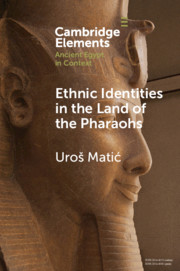Element contents
Ethnic Identities in the Land of the Pharaohs
Published online by Cambridge University Press: 23 November 2020
Summary
- Type
- Element
- Information
- Online ISBN: 9781108885577Publisher: Cambridge University PressPrint publication: 17 December 2020
References
- 20
- Cited by

